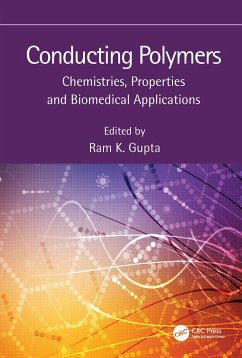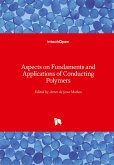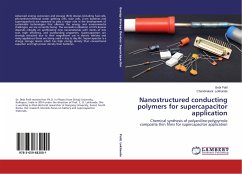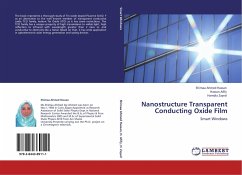Conducting Polymers
Chemistries, Properties and Biomedical Applications
Herausgeber: Gupta, Ram K.
Conducting Polymers
Chemistries, Properties and Biomedical Applications
Herausgeber: Gupta, Ram K.
- Gebundenes Buch
- Merkliste
- Auf die Merkliste
- Bewerten Bewerten
- Teilen
- Produkt teilen
- Produkterinnerung
- Produkterinnerung
This book will cover the fundamentals of conducting polymers, strategies to modify the structure of conducting polymers to make them biocompatible, and their applications in various biomedical areas like drug/gene delivery, tissue engineering, antimicrobial activities, biosensors, etc.
Andere Kunden interessierten sich auch für
![Aspects on Fundaments and Applications of Conducting Polymers Aspects on Fundaments and Applications of Conducting Polymers]() Aspects on Fundaments and Applications of Conducting Polymers84,99 €
Aspects on Fundaments and Applications of Conducting Polymers84,99 €![Concepts and Applications of Conducting Polymers Concepts and Applications of Conducting Polymers]() Concepts and Applications of Conducting Polymers105,99 €
Concepts and Applications of Conducting Polymers105,99 €![Conducting Polymers Conducting Polymers]() Conducting Polymers84,99 €
Conducting Polymers84,99 €![Nanostructured conducting polymers for supercapacitor application Nanostructured conducting polymers for supercapacitor application]() Bebi PatilNanostructured conducting polymers for supercapacitor application41,99 €
Bebi PatilNanostructured conducting polymers for supercapacitor application41,99 €![Transparent Conducting Films Transparent Conducting Films]() Transparent Conducting Films115,00 €
Transparent Conducting Films115,00 €![Transparent Conducting Oxides Transparent Conducting Oxides]() T. Sreenivasulu ReddyTransparent Conducting Oxides36,99 €
T. Sreenivasulu ReddyTransparent Conducting Oxides36,99 €![Nanostructure Transparent Conducting Oxide Film Nanostructure Transparent Conducting Oxide Film]() Shimaa Ahmed HassanNanostructure Transparent Conducting Oxide Film39,99 €
Shimaa Ahmed HassanNanostructure Transparent Conducting Oxide Film39,99 €-
-
-
This book will cover the fundamentals of conducting polymers, strategies to modify the structure of conducting polymers to make them biocompatible, and their applications in various biomedical areas like drug/gene delivery, tissue engineering, antimicrobial activities, biosensors, etc.
Produktdetails
- Produktdetails
- Verlag: CRC Press
- Seitenzahl: 360
- Erscheinungstermin: 19. April 2022
- Englisch
- Abmessung: 260mm x 183mm x 24mm
- Gewicht: 872g
- ISBN-13: 9781032071091
- ISBN-10: 1032071095
- Artikelnr.: 62883997
- Herstellerkennzeichnung
- Libri GmbH
- Europaallee 1
- 36244 Bad Hersfeld
- gpsr@libri.de
- Verlag: CRC Press
- Seitenzahl: 360
- Erscheinungstermin: 19. April 2022
- Englisch
- Abmessung: 260mm x 183mm x 24mm
- Gewicht: 872g
- ISBN-13: 9781032071091
- ISBN-10: 1032071095
- Artikelnr.: 62883997
- Herstellerkennzeichnung
- Libri GmbH
- Europaallee 1
- 36244 Bad Hersfeld
- gpsr@libri.de
Dr. Ram Gupta is an Associate Professor at Pittsburg State University. Dr. Gupta's research focuses on conducting polymers and composites, green energy production and storage using biowastes and nanomaterials, optoelectronics and photovoltaics devices, organic-inorganic hetero-junctions for sensors, bio-based polymers, flame-retardant polymers, bio-compatible nanofibers for tissue regeneration, scaffold and antibacterial applications, corrosion inhibiting coatings, and bio-degradable metallic implants. Dr. Gupta has published over 230 peer-reviewed articles, made over 280 national, international, and regional presentations, chaired many sessions at national/international meetings, edited many books, and written several book chapters. He has received over two and a half million dollars for research and educational activities from many funding agencies. He is serving as Editor-in-Chief, Associate Editor, and editorial board member of numerous journals.
1. Conducting Polymers: An Introduction 2. Conducting Polymers:
Fundamentals to Biomedical Applications 3. Conducting Polymers:
Fundamentals, Synthesis, Properties, and Applications 4. Chemistries and
Biodegradability of Conducting Polymers 5. Strategies to Synthesize
Biodegradable Conducting Polymers 6. Biodegradable Polymers: Synthesis to
Advanced Biomedical Applications 7. Hybrid Conductive Polymers: Synthesis,
Properties, and Multifunctionality 8. Electrically Conductive Polymers and
Composites for Biomedical Applications 9. Conducting Polymers for Gene
Delivery 10. Conducting Polymers for Regenerative Medicine 11. Conducting
Polymers as Efficient Materials for Tissue Engineering 12. Conducting
Polymer-Based Nanomaterials for Tissue Engineering 13. Conducting Polymers
for Neural Tissue Engineering 14. Conducting Polymers for Ophthalmic
Applications 15. Conducting Polymers for Biomedical Imaging 16. Conducting
Polymer-Based Micro-Containers for Biomedical Applications 17.
Antimicrobial Activities of Conducting Polymers and Their Derivatives 18.
Biodegradable Electronic Devices 19. Microfluidic Devices with Integrated
Conductive Polymeric Electrodes for Biosensing Applications 20. Advantages
and Challenges of Biodegradable Electronic Devices 21. Conducting Polymers:
An Efficient Way to Deal with Medical and Industrial Fouling 22.
Antifouling Properties and Biomedical Applications of Conducting Polymers
Fundamentals to Biomedical Applications 3. Conducting Polymers:
Fundamentals, Synthesis, Properties, and Applications 4. Chemistries and
Biodegradability of Conducting Polymers 5. Strategies to Synthesize
Biodegradable Conducting Polymers 6. Biodegradable Polymers: Synthesis to
Advanced Biomedical Applications 7. Hybrid Conductive Polymers: Synthesis,
Properties, and Multifunctionality 8. Electrically Conductive Polymers and
Composites for Biomedical Applications 9. Conducting Polymers for Gene
Delivery 10. Conducting Polymers for Regenerative Medicine 11. Conducting
Polymers as Efficient Materials for Tissue Engineering 12. Conducting
Polymer-Based Nanomaterials for Tissue Engineering 13. Conducting Polymers
for Neural Tissue Engineering 14. Conducting Polymers for Ophthalmic
Applications 15. Conducting Polymers for Biomedical Imaging 16. Conducting
Polymer-Based Micro-Containers for Biomedical Applications 17.
Antimicrobial Activities of Conducting Polymers and Their Derivatives 18.
Biodegradable Electronic Devices 19. Microfluidic Devices with Integrated
Conductive Polymeric Electrodes for Biosensing Applications 20. Advantages
and Challenges of Biodegradable Electronic Devices 21. Conducting Polymers:
An Efficient Way to Deal with Medical and Industrial Fouling 22.
Antifouling Properties and Biomedical Applications of Conducting Polymers
1. Conducting Polymers: An Introduction 2. Conducting Polymers:
Fundamentals to Biomedical Applications 3. Conducting Polymers:
Fundamentals, Synthesis, Properties, and Applications 4. Chemistries and
Biodegradability of Conducting Polymers 5. Strategies to Synthesize
Biodegradable Conducting Polymers 6. Biodegradable Polymers: Synthesis to
Advanced Biomedical Applications 7. Hybrid Conductive Polymers: Synthesis,
Properties, and Multifunctionality 8. Electrically Conductive Polymers and
Composites for Biomedical Applications 9. Conducting Polymers for Gene
Delivery 10. Conducting Polymers for Regenerative Medicine 11. Conducting
Polymers as Efficient Materials for Tissue Engineering 12. Conducting
Polymer-Based Nanomaterials for Tissue Engineering 13. Conducting Polymers
for Neural Tissue Engineering 14. Conducting Polymers for Ophthalmic
Applications 15. Conducting Polymers for Biomedical Imaging 16. Conducting
Polymer-Based Micro-Containers for Biomedical Applications 17.
Antimicrobial Activities of Conducting Polymers and Their Derivatives 18.
Biodegradable Electronic Devices 19. Microfluidic Devices with Integrated
Conductive Polymeric Electrodes for Biosensing Applications 20. Advantages
and Challenges of Biodegradable Electronic Devices 21. Conducting Polymers:
An Efficient Way to Deal with Medical and Industrial Fouling 22.
Antifouling Properties and Biomedical Applications of Conducting Polymers
Fundamentals to Biomedical Applications 3. Conducting Polymers:
Fundamentals, Synthesis, Properties, and Applications 4. Chemistries and
Biodegradability of Conducting Polymers 5. Strategies to Synthesize
Biodegradable Conducting Polymers 6. Biodegradable Polymers: Synthesis to
Advanced Biomedical Applications 7. Hybrid Conductive Polymers: Synthesis,
Properties, and Multifunctionality 8. Electrically Conductive Polymers and
Composites for Biomedical Applications 9. Conducting Polymers for Gene
Delivery 10. Conducting Polymers for Regenerative Medicine 11. Conducting
Polymers as Efficient Materials for Tissue Engineering 12. Conducting
Polymer-Based Nanomaterials for Tissue Engineering 13. Conducting Polymers
for Neural Tissue Engineering 14. Conducting Polymers for Ophthalmic
Applications 15. Conducting Polymers for Biomedical Imaging 16. Conducting
Polymer-Based Micro-Containers for Biomedical Applications 17.
Antimicrobial Activities of Conducting Polymers and Their Derivatives 18.
Biodegradable Electronic Devices 19. Microfluidic Devices with Integrated
Conductive Polymeric Electrodes for Biosensing Applications 20. Advantages
and Challenges of Biodegradable Electronic Devices 21. Conducting Polymers:
An Efficient Way to Deal with Medical and Industrial Fouling 22.
Antifouling Properties and Biomedical Applications of Conducting Polymers









